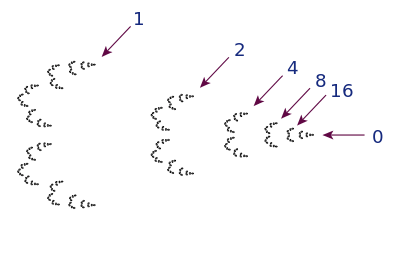p-adic order
In number theory, for a given prime number p, the p-adic order or p-adic valuation of a non-zero integer n is the highest exponent such that divides n. The p-adic valuation of 0 is defined to be infinity. The p-adic valuation is commonly denoted . If n/d is a rational number in lowest terms, so that n and d are coprime, then is equal to if p divides n, or if p divides d, or to 0 if it divides neither. The most important application of the p-adic order is in constructing the field of p-adic numbers. It is also applied toward various more elementary topics, such as the distinction between singly and doubly even numbers.[1]

Definition and properties
Integers
Let p be a prime number. The p-adic order or p-adic valuation for ℤ is the function [2] defined by
where denotes the natural numbers.
For example, since .
Rational numbers
The p-adic order can be extended into the rational numbers as the function [3] defined by
For example, .
Some properties are:
Moreover, if , then
where min is the minimum (i.e. the smaller of the two).
p-adic absolute value
The p-adic absolute value on ℚ is defined as |·|p : ℚ → ℝ
For example, and .
The p-adic absolute value satisfies the following properties.
Non-negativity Positive-definiteness Multiplicativity Non-Archimedean
The symmetry follows from multiplicativity and subadditivity from the non-Archimedean triangle inequality .
A metric space can be formed on the set ℚ with a (non-Archimedean, translation-invariant) metric defined by d : ℚ × ℚ → ℝ
The p-adic absolute value is sometimes referred to as the "p-adic norm", although it is not actually a norm because it does not satisfy the requirement of homogeneity.
The choice of base p in the formula makes no difference for most of the properties, but results in the product formula:
where the product is taken over all primes p and the usual absolute value (Archimedean norm), denoted . This follows from simply taking the prime factorization: each prime power factor contributes its reciprocal to its p-adic absolute value, and then the usual Archimedean absolute value cancels all of them.
References
- Dummit, David S.; Foote, Richard M. (2003). Abstract Algebra (3rd ed.). Wiley. ISBN 0-471-43334-9.
- Ireland, K.; Rosen, M. (2000). A Classical Introduction to Modern Number Theory. New York: Springer-Verlag. p. 3.
- Khrennikov, A.; Nilsson, M. (2004). p-adic Deterministic and Random Dynamics. Kluwer Academic Publishers. p. 9.